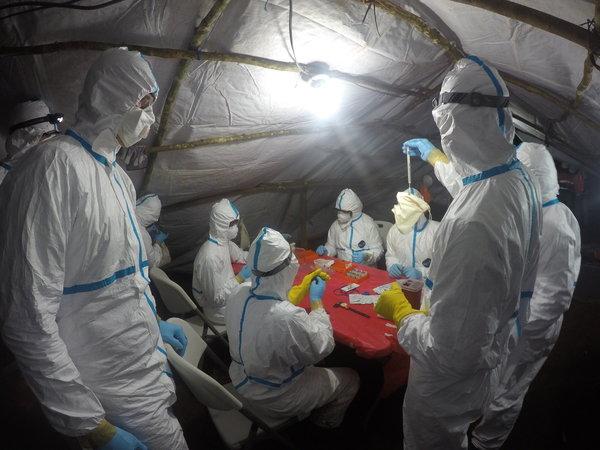For the first time, the type of deadly Ebola virus responsible for recent epidemics has been found in a bat in West Africa, Liberian health officials announced on Thursday.
Bats carrying the disease had already been found in Central Africa, and scientists have long suspected that bats were a natural host of Ebola and a source of some human infections in other areas as well. But until now they had not found any bats in West Africa that harbored the epidemic species, known as Zaire ebolavirus.
Although the bat was found in Liberia, the country has not had any human cases of Ebola since 2016, and the bat was not associated with any illness in people.
The finding is preliminary and not yet ready for publication in a peer-reviewed journal, the usual venue for presenting scientific discoveries. Only 20 percent of the bat’s genome has been studied, and research on it is continuing.
But because of its potential impact on public health, officials in Liberia wanted to share the information widely as soon as possible.
“It’s an incomplete study, a work in progress,” said Simon J. Anthony, a virologist at Columbia University who has performed genetic analyses on samples from the infected bat. “It feels premature scientifically, but on the other hand, you have the public health aspect. We do have enough data to suggest to me that it is Ebola Zaire in this bat. We agree with our Liberian government partners that this information should be shared.”

Knowing which types of bat carry Ebola may help health officials prevent outbreaks by educating the public about how to prevent contact with the creatures, scientists said. The newly implicated bat roosts in caves and mines, so people can be warned to avoid those places.
But Dr. Anthony said there were probably more bat species, with different habitats, that might also carry the virus.
Avoiding caves is clear-cut advice, but other routes of infection may be harder to block: People in many parts of the world eat bats, and may be infected while catching or preparing them for cooking. Hunters and cooks may not be able to tell one bat species from another.
The researchers said the findings did not mean that bats should be exterminated. They protect humans and crops by eating insects and pollinating fruit trees. Disrupting complex ecosystems by slaughtering bats could even make disease outbreaks worse.
Zaire ebolavirus is the cause of the current epidemic in the Democratic Republic of Congo, with more than 700 cases and more than 400 deaths. The outbreak, which has spun out of control in a war-torn region, is the second largest ever. The largest, caused by the same Ebola species, occurred in West Africa from 2013 to 2016, infecting nearly 30,000 people and killing 11,000.
The West African epidemic, in Guinea, Liberia and Sierra Leone, is thought to have begun with a small boy in Guinea handling an infected bat, but the origin is not known for sure.
[Like the Science Times page on Facebook. | Sign up for the Science Times newsletter.]
A Liberian team in full protective gear — Tyvek suits, gloves, masks, goggles, hoods, boots — trapped and released 5,000 bats from about 10 species. They took samples of blood, urine and feces, and oral swabs.
Dr. Anthony’s lab at Columbia found genetic material from the virus in a mouth swab taken from just one bat, captured in Liberia’s northeastern Nimba District. That animal was a greater long-fingered bat, from the species Miniopterus inflatus, a furry beast the size of a small mouse, weighing half an ounce, with a 12-inch wingspan. It eats insects.

Tests also found that the bat had antibodies to the Zaire ebolavirus, an immune system response, providing further evidence that it had been infected.
The research team came from the Liberian government, Columbia University, the University of California, Davis and EcoHealth Alliance, a nonprofit group that studies emerging diseases that originate in animals and spill over into humans. The research was paid for by the United States Agency for International Development and is part of a project called Predict, which is trying to find viruses before they jump into humans and cause epidemics.
The bat did not appear sick from the virus, and scientists do not know how the animals become infected. The bats and Ebola have probably been associated for a long time and most likely evolved together, said Jonathan Epstein, a veterinarian and EcoHealth Alliance’s vice president for science and outreach.
Laboratory work is still going on to determine whether the virus found in the bat is the exact same strain that caused the large West African epidemic. So far, the 20 percent of the viral genome that has been analyzed closely matches the epidemic strain, Dr. Anthony said.
He said the team had analyzed 3,000 of the 12,000 collected samples from the bats so far.
“We’ve got quite a bit of work to do,” he said.
Bats carry a number of other viruses that are deadly to humans, including rabies, SARS (severe acute respiratory syndrome), Nipah and Marburg, a relative of Ebola. There is no simple answer as to why.
“That’s a question for the ages,” Dr. Epstein said. “People may think of bats as one animal, but there are more than 1,400 different kinds of bats.”
Bats account for 20 percent of all mammalian species.
“They’re an ancient order of mammals that have been around for millions of years,” Dr. Epstein said. “In terms of evolutionary time scales, they’ve spent a long time with these viruses, and there’s lots of opportunity for contact with livestock or people.”
Last year, researchers involved in the Predict project found the Marburg virus in fruit bats in Sierra Leone, the first time Marburg was detected in West Africa. Predict scientists also discovered a previously unknown Ebola species in Sierra Leone — Bombali ebolavirus — in bug-eating bats that roost inside people’s houses.
Neither discovery was linked to an outbreak in people, which the scientists said was exactly what they hoped to accomplish: finding viruses before they sicken people. They said the Bombali virus had the potential to infect humans.



